Dr Gethin Matthews is wrestling with this problem, as he runs the JISC-funded project, Welsh Voices of The Great War Online.
At the RunCoCo workshop on 27 July Gethin explained how he is trying to get people to come to public submissions days, and now you can see the slides (PDF 1.5Mb) and listen to the audio (MP3 20Mb) from his presentation.
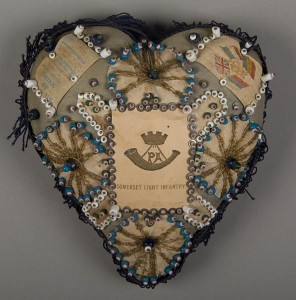
Embroidered heart, photo submitted to The Welsh Voices project
Welsh Voices was inspired, if that’s the correct tone, by The Great War Archive, which we ran at the University of Oxford in 2008. The project has written in detail about engaging with the public in an article in EDUCAUSE Quarterly, (If You Build It, They Will Scan: Oxford University’s Exploration of Community Collections). At RunCoCo workshops we have presented about How the Public Contributed to The Great War Archive (slides with presenter’s notes PDF), (audio 20Mb). With these resources, and with direct advice from the Oxford team Gethin is running an online collection supplemented by public roadshows throughout Wales this summer:
- St Fagans 24 July (National History Museum)
- Wrexham 31 July (Bersham Heritage Centre)
- Ebbw Vale 3 & 6 August (talks at National Eisteddfod)
- Aberystwyth 17 August (National Library of Wales)
- Newport 24 August (Newport Museum)
- Swansea 25 August (National Waterfront Museum)
- Blaenavon 18 Sept (Big Pit museum)
- Llanberis 2 Oct (National Slate Museum)
From the presentation (audio 20Mb) on 27 July you can hear the frustration in Gethin’s voice as he describes how he carefully prepared for the first submissions day at St Fagans, for only a handful of contributors to turn up. Apparently it was a similar tale at Wrexham and Aberystwyth. What was he doing wrong? However, with little change in strategy, Gethin reports this week that “we had very strong turnouts at Newport and Swansea. In fact, Swansea was totally manic – they started arriving at 9.40a.m. and kept on coming to the end“. But as Gethin says, this raises more questions than answers. Maybe timing these submissions days during the holiday season affected some events?
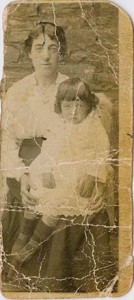
David Thomas (“Dai Slogger”) from Abertridwr near Caerphilly carried this photograph (left) of his wife and child throughout his service with the Royal Field Artillery, image contributed to the Welsh Voices collection.
Gethin had managed to get stories into the local newspapers, and even been interviewed for BBC Radio Wales and the Welsh TV news on S4C. My faith in the icons of Welsh radio in particular was rocked, as Gethin recorded that no-one came to the early submissions roadshows as a result of his broadcast media spots. As found for The Great War Archive, exposure in the local rag is key in motivating people to come. Genuine interest appears to have been piqued for the two most recent roadshows by a story in the South Wales Evening Post, and Gethin has followed up with further news stories like this in the South Wales Argus and from the BBC.
These news stories are just part of the armoury of a project manager like Gethin, who should be using their institution’s press office (Cardiff University press story), as well as social media like Twitter and project blogs. There will also be a wide variety of local community or special interest groups who you should try to get on board, and leaflet drops at local libraries should be considered. This weekend I spent a couple of hours at a local history event at the end of a week long series of talks, and muscled-in with information about the Welsh Voices project. Unknown to me the speaker had mentioned the project in previous talks and I was met with a small group with their family keepsakes and stories, showing the power of Word-of-Mouth and that allowing sufficient time for that interest to spread is paramount.
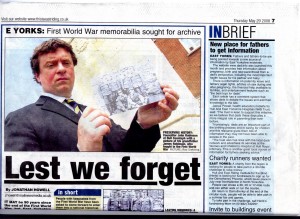
Local newspaper story to attract contributions to The Great War Archive submissions roadshow in Hull, 2008
RunCoCo will be pulling together all this into guidelines for projects like Welsh Voices of The Great War Online. In the meantime I leave you with some further treasures from the recent public submissions days:

A First World War bayonet brought along to the Welsh Voices roadshow in Newport
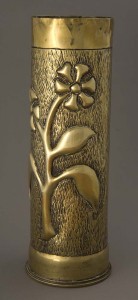
An example of 'trench art' - a casing from a large shell which had been transformed into an umbrella stand - brought along to the roadshow.
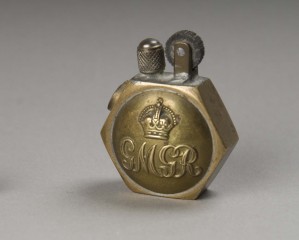
A 'lucifer' - cigarette lighter customised with a tunic button from the man's tunic, (GMGR: Guard's Machine Gun Regiment)
[…] This post was mentioned on Twitter by Culturenet Cymru, RunCoCo project. RunCoCo project said: How do you encourage the public to take part in your community collection project? http://bit.ly/bcBqhi […]
[…] the National Library of Wales and the Welsh Voices of the Great War Online currently collecting (blog post for further information) from their base at the University of Cardiff. But these have not made great play of the […]